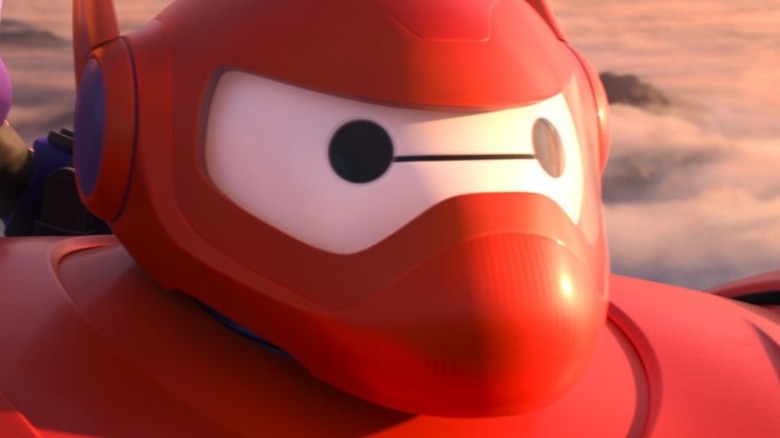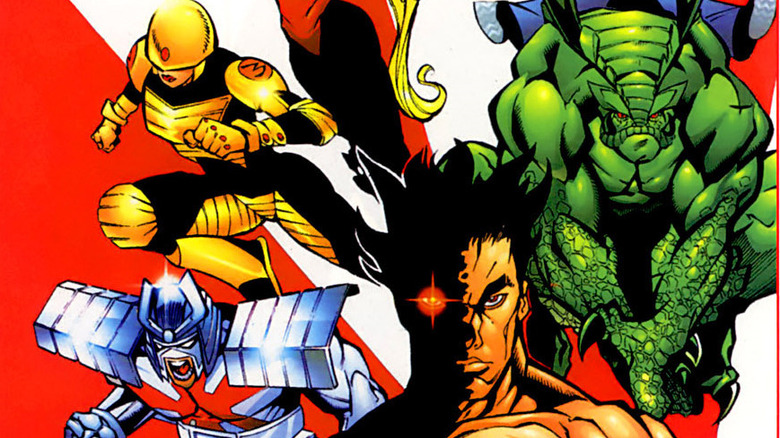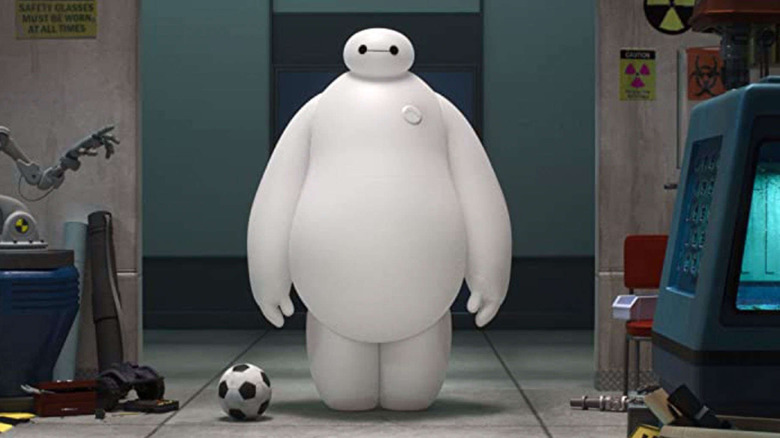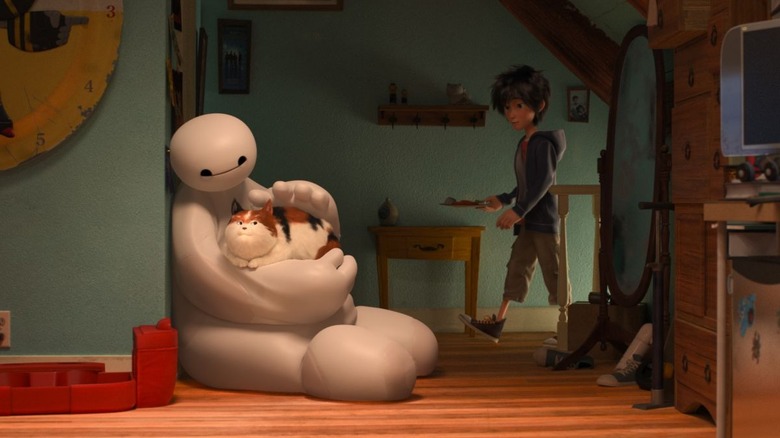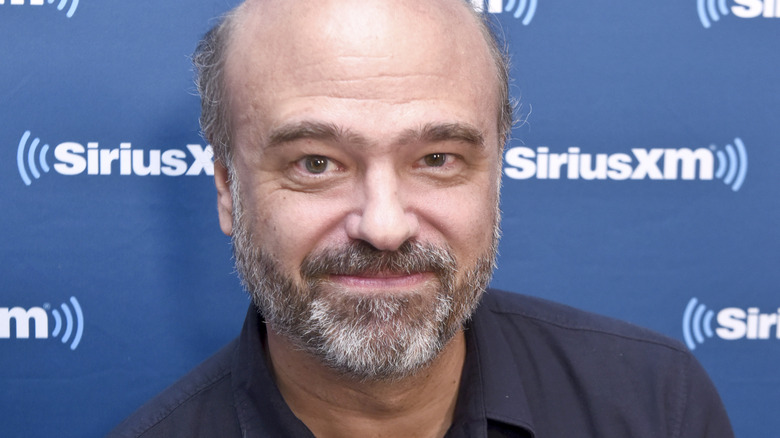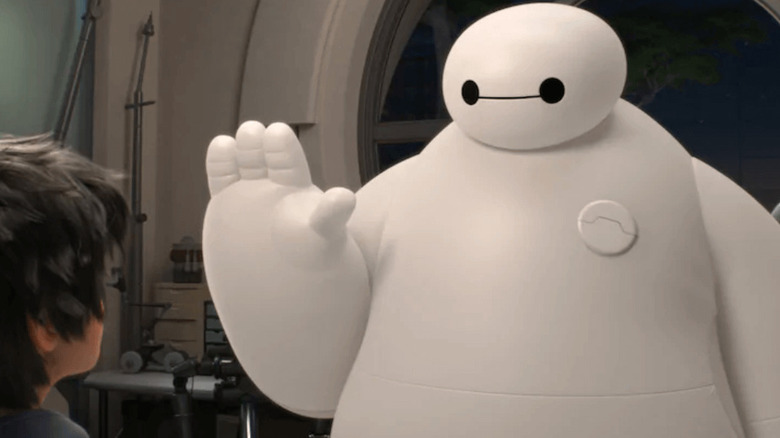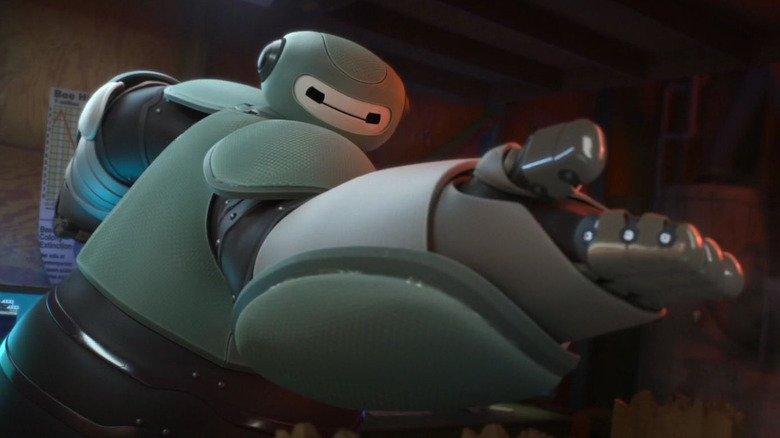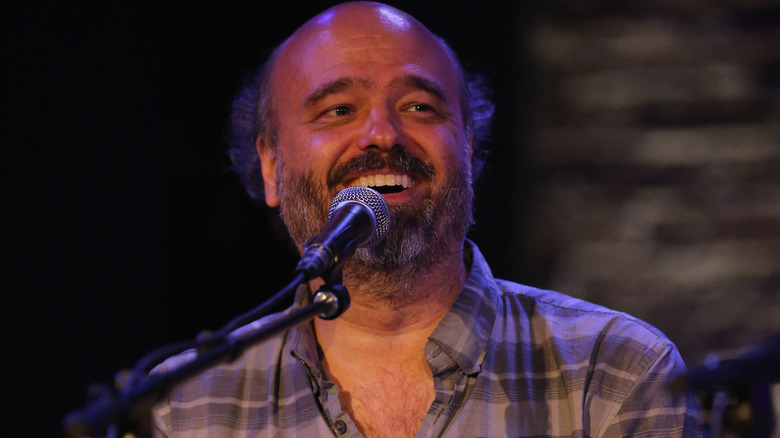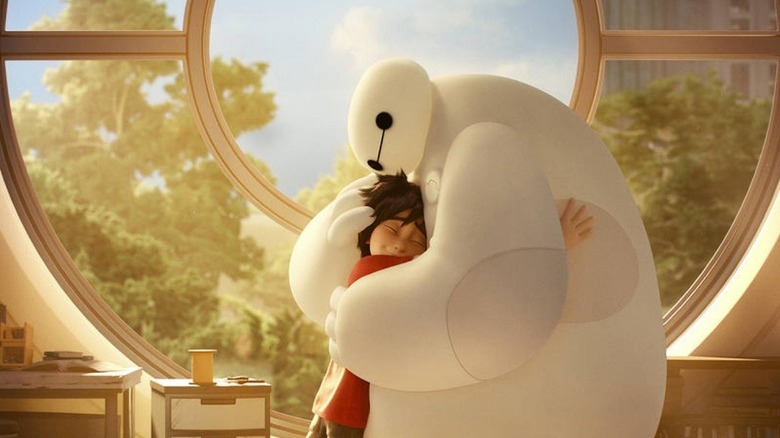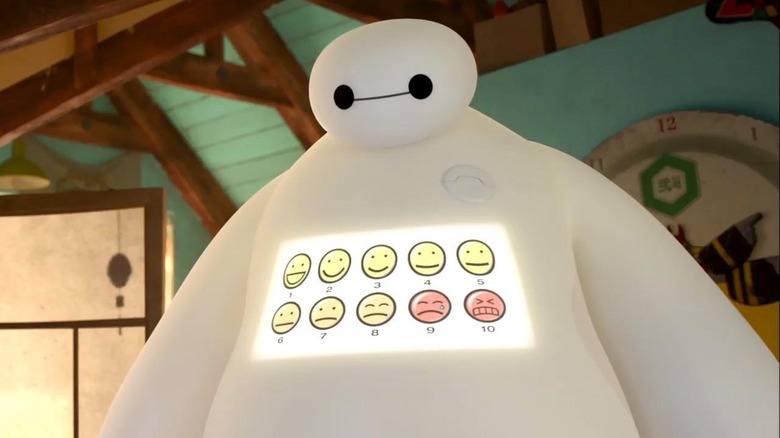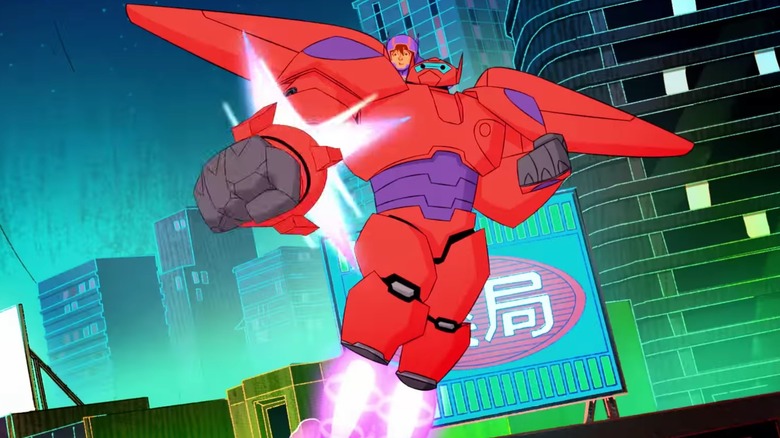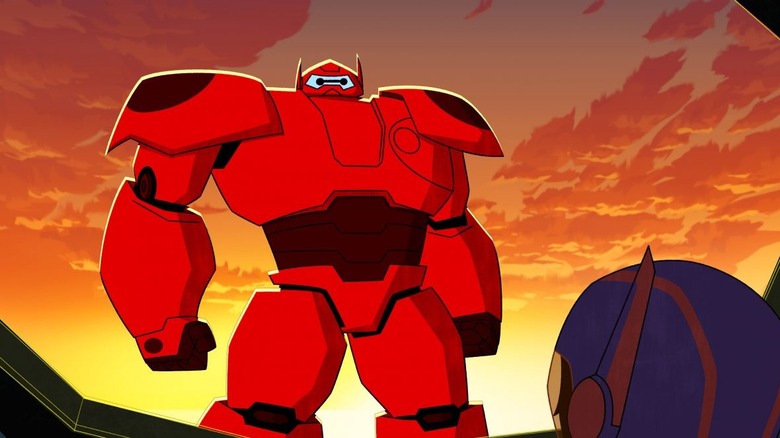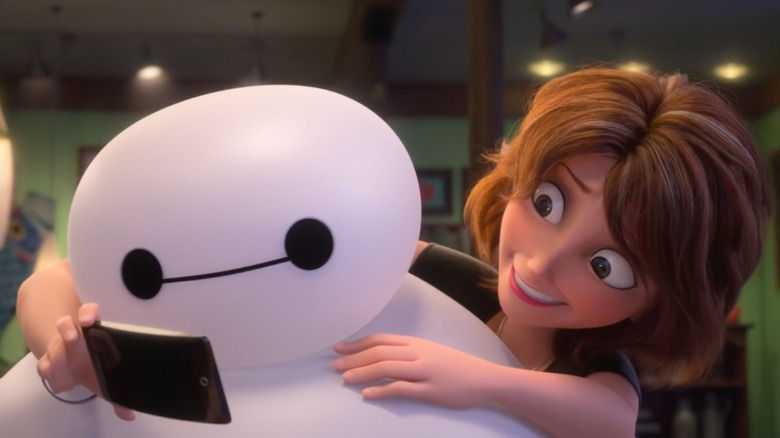The Untold Truth Of Baymax
There are many cute and cuddly sidekicks in the pantheon of Walt Disney Animation Studios characters. Few of them, however, are quite as squishy as Baymax (Scott Adsit), the robot companion from the 2014 feature "Big Hero 6." Introduced as a creation meant to help young people in healthcare scenarios, Baymax is eventually upgraded to fight crime alongside best friend Hiro (Ryan Potter) and four other superheroes. In the years since "Big Hero 6" was released, Baymax has become a beloved figure that shows up at Disney's theme parks, in the toy collections of children around the globe, and even in other "Big Hero 6" spin-off material, such as "Big Hero 6: The Series." Needless to say, Baymax has turned into quite the popular character.
Even with how recognizable he's become, there's still lots about Baymax that most fans aren't fully aware of. Ever wondered what the original comic book version of Baymax was like? What about what the process was like for discovering the robot's voice actor? How about the ways new animation technology was created to properly realize this figure? Baymax has lots of surface-level qualities that make it easy to see why so many people want to give him a big hug, but diving into the untold truth of this Disney Animation sidekick makes it apparent there's much more to love about this heroic robot.
Baymax has many different representations in comics
It's no secret that Disney's "Big Hero 6" is significantly different than the Marvel comics that inspired it. This includes Baymax, whose depiction in the comics is almost unrecognizable to fans who only know the character from the film. Created by Steven T. Seagle and Duncan Rouleau and debuting in the Marvel comics continuity in 1998, as noted by Entertainment Weekly, the initial comics vision of Baymax looked like a gigantic green dragon while his armored form was primarily grey with orange and green accents.
One noticeable similarity between the two versions of Baymax, though, is how they represent Hiro's ability to connect with close relatives that have passed on. In the "Big Hero 6" movie, this is manifested through Baymax's creation resulting from a passion project of Hiro's older brother. As a result, Baymax and Hiro's friendship is a way for Hiro to process the loss of a sibling. However, in the original comics, Baymax is inhabited by the mind of Hiro's dead father, Tomeo Takachiho. Using the body of this robot, this father and son duo can continue their relationship in a slightly different form. This critical detail of Baymax's comic incarnation is one of many ways the "Big Hero 6" movie went on a different path when adapting this superhero for the silver screen.
Research influenced Baymax's creation
Since Baymax was always intended to be different from his comic book counterpart, the team in charge of designing this character couldn't just turn to the source material to guide the appearance of this robot. Instead, they found creative inspiration in unexpected places. Despite Baymax being a robot who can punch villains and fly into alternate dimensions, the ultimate "Eureka!" moment for realizing this individual came about thanks to some inspiration from reality.
When directors Don Hall and Chris Williams went to real laboratories and technology to research "Big Hero 6," they absorbed so much about real-life robotics that the trip ended up being a primary influence on how Baymax should look and behave. "Baymax is the perfect example of that as the process working so well," director Hall said to Geeks of Doom. "Because prior to that Carnegie Mellon research trip, there was no inflatable robot, there was no character Baymax, there was a name, there was an idea to use a robot. It was such a profound part of our process."
Though Baymax is decidedly a fantastical creation, getting exposed to the realities of robotics had an enormous influence on shaping the character on the path "Big Hero 6" took to the big screen.
Baymax was meant to look different from other movie robots
Think of the history of robots in movies. Chances are you'll start to realize just how often cinema has turned to mechanical beings to tell exciting stories, dating back to the days of "Metropolis." Since then, the likes of C-3PO, Mechagodzilla, and even Rodney Copperbottom, among many others, have all made their mark on the big screen. If you're gonna make a new robot in cinematic storytelling, you better have a unique way to approach this concept, or your creation will end up rehashing the past.
Visions of classic movie robots danced across the minds of the folks behind "Big Hero 6" and influenced key design choices in the character of Baymax. Specifically, as told to Bloomberg, the crew realized that most movie robots were made out of metal. Thus, the decision was made to render Baymax out of soft rubber foam. This movie robot would be squishy, in contrast to other automatons that were made out of harder surfaces. Differentiating this character from other movie bots also influenced the choice to give Baymax a rotund figure. There's a lot of pressure when it comes to making a new movie robot, but being cognizant of design motifs of the past ensued up influencing Baymax's appearance for the better.
A one-man show led to Baymax finding his voice
If you get on the pop culture radar as a funny actor, chances are you're going to be eyeballed by movie studios for acting opportunities. That's how it's gone in the past with comedic performers like Robin Williams or Billy Crystal, who gained enough notoriety in their adult-skewing performances to garner the attention of Disney's animation studios. Considering Scott Adsit had a lead role on the popular NBC sitcom "30 Rock" for many years, one might imagine that this was the role that paved the way for Adsit voicing the robot Baymax in "Big Hero 6."
In actuality, there were humbler origins for how Adsit got onto Disney's radar. Talking to Wired, Adsit revealed that he did a one-man show in Los Angeles at a tiny venue that, one night, happened to have some people from Disney in the audience. The show went over so well with these viewers that they reached out to see if he would be interested in a role in "Big Hero 6." Though it sounds like a Cinderella story that stumbled into reality, it does make sense that Adsit's work here would spark to the folks behind "Big Hero 6." One-man shows require performers to make a lot out of very little, a talent that's very useful when voicing a character with restrained vocals like Baymax.
Scott Adist's process for finding Baymax's voice
Today, it's impossible to look at a picture of Baymax and not imagine the character's distinctive voice saying something calm but unintentionally humorous. Once upon a time, though, Baymax was just another character being molded in a movie years away from release. As this robot was getting fine-tuned during the production phase, it took a lot of trial-and-error for Scott Adsit to get the vocals for Baymax just right.
Talking to Collider, Adsit revealed that his inspiration for Baymax's voice started with how the audition slide for the role described the robot. Knowing the character was supposed to be "benign and friendly," Adist proceeded to put on as unthreatening of a voice as possible. After nailing that down, Adsit threw in an "automatic phone system voice" for a little flavor that would accentuate the robotic nature of Baymax. Adsit was also guided by contemplating what kind of voice people would want when they're sick or in need of medical attention. Considering these qualities, Adsit had to figure out a way that balance all those disparate vocals instincts together, a process that took a while to coalesce. However, once Adsit got this process down, he conjured up a voice for Baymax that nobody will ever forget.
What it was like for the Big Hero 6 directors to see people loving Baymax merchandise
Animated Disney movies have a noticeable habit of spawning lots of successful merchandise. Just think of all the plastic playthings sold by the likes of "Toy Story" or "Frozen." These objects don't just put money in the pocket of Disney executives or reflect the enduring appeal of a particular feature. They can also be a symbol of how deeply a specific movie has resonated with audiences. This is a fact that the directors of "Big Hero 6" have become extremely conscious of thanks to Baymax becoming an enormously popular toy.
"I've seen lots of people with the vinyl Baymax, and the armored Baymax," director Chris Williams said to Geeks of Doom about his encounters with people clutching Baymax merchandise. "It's a fun thing to see it, but it means that the audience wants to take the characters home, and they want the characters to live outside the film, and that's one of the things that Disney movies can do really well. So that's what I think is a fun benefit of working at Disney animation." It's a truly touching experience to see characters you work hard on resonating so deeply with audiences. Oh, and all those merchandising dollars, those are also probably pretty exciting to see pour in.
Scott Adsit's first reaction to seeing Baymax concept art
When you're a voice actor in an animated movie, it can be an isolating experience. Usually, performers record their dialogue alone, often with no other actors to bounce off of. You're not acting against sets or even props. While stage or live-action acting is usually a communal experience where actors play off the other artists, there's a solitary quality to the art of voice acting. Baymax voice actor Scott Adsit, for example, was so detached from the process of "Big Hero 6" coming together that he had a genuinely shocking reaction to seeing the concept art for the character he was voicing.
Speaking to Collider, Adsit revealed that the experience of seeing Baymax in concept art form made him immediately believe Disney would remove his vocals for the character. For Adsit, Baymax was just so endearing and expressive already when walking around ("like a baby penguin," as the actor put it) that he was worried his pipes would merely distract from the character. Despite Adsit being convinced that Baymax could work great as a silent character, his vocals remained in the final cut and proved to be integral to defining the robot's charm. All of that from an experience that could prove so isolating!
How a Baymax cosplayer left his mark on Big Hero 6 director Don Hall
A decent way of determining whether or not a movie character has resonated with the public is to see if people have started dressing up as that figure at comic conventions. Once the general public starts donning cosplay to look like a certain film character, you know that fictitious individual has struck a chord with audiences. Why else would people spend so much time making an intricate costume if that character didn't connect with them?
It was through the wonders of cosplay that "Big Hero 6" director Don Hall, per an interview with Geeks of Doom, realized that Baymax had left his mark on audiences even before that feature hit movie theaters. Just based on the film's initial teaser trailer, Hall encountered a man dressed as Baymax at a 2014 Comic-Con. The costume even came with a functioning computer screen that displayed an image of Hall himself, the sign of a truly dedicated and knowledgable fan. Having spotted cosplay of Baymax this early on was clear to Hall that this character was registering as something special to moviegoers, something the eventual positive response to Baymax and "Big Hero 6" would reflect.
The technology hurdles in animating Baymax
From the outset, Baymax looks like quite a simple character. He's a plush robot that looks like a slightly more husky and cuddly version of a crash test dummy. Surely such a figure wouldn't be that difficult to animate, especially for the artists who work at Walt Disney Animation Studios. In reality, though, Baymax proved to be a significant challenge for the animators beyond "Big Hero 6," who had to come up with new technology to ensure that light would appear realistic on the huggable character.
In a profile by Tech Republic, artists from Disney Animation broke down how a new software program called Hyperion was created specifically for "Big Hero 6" to ensure that Baymax could have realistic light emanating from and reflected off of his form. Through using this piece of groundbreaking animation technology, the animators were able to ensure that Baymax could look like a functional robot without sacrificing his appealing design in the process. The new software was especially helpful as early versions of the character created without Hyperion ended up emphasizing his interior skeleton. That's a lot of work for a character that seems so endearingly simple on the surface!
What it was like translating Baymax to television
A TV show based on a movie cannot expect to be successful by simply rehashing what came before it. That may be an easy creative solution when developing this kind of project, but it won't result in something that satisfies viewers. These were the truths facing the filmmakers in charge of bringing "Big Hero 6: The Series" to life, as they had to remain faithful to a beloved Disney Animation feature while also delivering something that could justify its existence as a standalone TV show.
"Big Hero 6: The Series" supervising director Nick Filippi noted to Animation Scoop that one particular struggle of bringing the movie and the character of Baymax to the small-screen was transitioning to hand-drawn animation. Whereas the movie was realized through computer-animated, "Big Hero 6: The Series" was going in a different visual direction. This was done to offer something unique compared to the movie and because characters like Baymax carried a "warm, appealing look" when captured through hand-drawn animation. Confronting these sorts of hurdles head-on ensured that the franchise would have an equally beloved TV show in the form of "Big Hero 6: The Series."
Scott Adsit's reaction to reprising Baymax on Big Hero 6: The Series
When you voice a part in a feature film, you spend a lot of time in recording sessions trying to get a character just right. However, spending such an elongated period voicing one individual can make it hard to say goodbye. For Baymax voice actor Scott Adsit, though, he didn't have to bid farewell to this cuddly robot for long. A few years after "Big Hero 6" hit movie theaters everywhere, news broke that "Big Hero 6: The Series" was headed to television, and the producers wanted Adsit back to voice Baymax again.
Talking to Collider, Adsit revealed that the first talks about the TV happened relatively soon after "Big Hero 6" debuted and that it was initially seen as a project to keep the crew busy while everyone took their time crafting a proper "Big Hero 6" sequel. "The series was set up pretty well, in the closing credits of the movie, when you saw hints of what their adventures were," Adist explained regarding the program. "I think they took that idea and just made it into a whole series, which I really like." Adsit also expressed initial excitement over getting to engage in more light-hearted adventures, rather than just explorations of grief, with the character of Baymax. Beyond that, after all the time Adsit spent voicing "Baymax" for "Big Hero 6," it must've been nice to return to a familiar robotic role.
Baymax and his own Disney+ show
After the release of "Big Hero 6" and the conclusion of "Big Hero 6: The Series," it was unclear where the stories of Baymax would go next. It turns out this robot was heading where many Disney characters go nowadays — to Disney+! After sharing the spotlight with five other superheroes in most of his media appearances, Baymax starred in a series of short films for Disney+ on "Baymax!"
Many Walt Disney Animation Studios titles have gone on to get TV adaptations or spin-offs, including "Big Hero 6." In the past, such projects have been handled by outside studios with new behind-the-scenes talent separate from the ones responsible for the original movie. However, "Baymax!" is a first in that it's the inaugural foray into television storytelling for Walt Disney Animation Studios, via /Film. It's the first of many similar programs that this animation house is producing as a way of ensuring that Disney+ has plenty of high-profile original content for its users. To further solidify the connections between "Baymax!" and the original film, "Big Hero 6" director Don Hall serves as the show's creator. These significant steps in how Disney Animation films get translated to TV ensure that this helpful robot received a spin-off that felt like a part of the original "Big Hero 6" movie.
